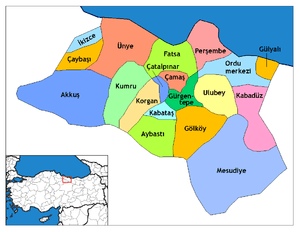Fatsa
Fatsa is a town and a district of Ordu Province in the central Black Sea region of Turkey. Population from Fatsa is more than 115,000.
Fatsa | |
|---|---|
Town | |
 A panoramic view of the town | |
 Fatsa Location of Fatsa | |
| Coordinates: 41°02′N 37°30′E | |
| Country | |
| Region | Black Sea |
| Province | Ordu |
| Government | |
| • Mayor | Muharrem Aktepe (AKP) |
| Area | |
| • District | 300.00 km2 (115.83 sq mi) |
| Elevation | 57- 550 m (−1,747 ft) |
| Population (2012)[2] | |
| • Urban | 74,602 |
| • District | 107,031 |
| • District density | 360/km2 (920/sq mi) |
| Time zone | UTC+2 (EET) |
| • Summer (DST) | UTC+3 (EEST) |
| Postal code | 52 |
| Area code(s) | 0452 |
| Licence plate | 52 |
| Climate | Cfa |
| Website | http://www.fatsa.gov.tr |
Name
The oldest recorded name of the town is Polemonion (Ancient Greek: Πολεμώνιον, Latinized as Polemonium), after Polemon I of Pontus. A derivative of Polemonion, i.e. Bolaman, is the modern name of the river passing through Fatsa (the river is the ancient Sidenus).[3] The present name, Fatsa, has been influenced by modern Greek Φάτσα or Φάτσα Πόντου (φἀτσα is derived from Italian faccia), which translates as "face or housefront on the sea", but has in fact mutated from Fanizan, the name of the daughter of King Pharnaces II of Pontus, through Fanise, Phadisana (Greek: Φαδισανή),[4] Phadsane[5] Phatisanê[6] Vadisani (Greek: Βαδισανή), Phabda,[7] Pytane, Facha, Fatsah[6][8] into today's Fatsa. Apart from Polemonion, another Greek name of the town was Side.[9]
History
Antiquity
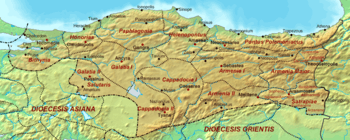
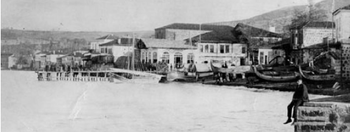
The history of Fatsa goes back to antiquity, when the coast was settled by Cimmerians, and Pontic Greeks in the centuries BC. The ruins on Mount Çıngırt (the ancient rock tombs and vaults) are from this period.
Roman and Byzantine periods
Fatsa was first mentioned, in the era of the Kingdom of Pontus, as Polemonium, after King Polemon I, the Roman client king appointed by Mark Antony. Under Nero, the kingdom became a Roman province in AD 62. In about 295, Diocletian (r. 284–305) divided the province into three smaller provinces, one of which was Pontus Polemoniacus, called after Polemonium, which was its administrative capital.
As the Roman Empire developed into the Byzantine Empire, the city lost some of its regional importance. Neocaesarea became the capital of the province, and the Diocese of Polemonion was a suffragan of the metropolitan see of Neocaesarea.[10] Due to partition of the Byzantine Empire as a result of the Fourth Crusade, Fatsa became a part of the Empire of Trebizond in 1204.
In the 13th and 14th centuries Genoese traders established trading posts on the Black Sea coast.[11] Fatsa became one of the most important of these ports. There is a stone warehouse on the shore built in this period.
Ottoman period
Following the conquest of the Empire of Trebizond by the Ottomans in 1461, Fatsa become a part of Rûm Eyalet and later a part of Trebizond Eyalet of the Ottoman Empire and remained within the Sanjak of Janik until the collapse of the Empire in 1921. Fatsa became a district of Ordu Province, following the formation of the Republic of Turkey in 1923.
Population movement
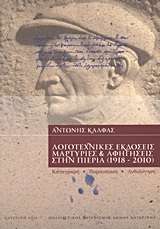
Following the Turkish conquest of Anatolia by the Seljuk Sultanate of Rum and later by the Ottomans, Muslims settler arrived at Fatsa in the middle of the 14th Century.[14] The early Muslim Turkish settlers included Turkomens, whose descendants make up the majority of Fatsa's current Alevi Muslim community.[15] In 1999, a religious worship complex that serves to both Alevis and Sunni Muslims was opened in Fatsa, which was unprecedented in Turkey.[16]
In the second half of the 19th century, Fatsa's Sunni population increased significantly, as some of Chveneburi (Sunni Muslim Georgians) from Batumi and Kobuleti (Turkish: Çürüksu), who fought in the Ottoman army against the Russian forces in Russo-Turkish War (1877–78) under Ali Pasha of Çürüksu[12] and some of the Abazins and Circassians,[17] who were forced to leave their ancestral land in North Caucasus after the end of the Caucasian War in 1864, were settled in Fatsa and in the surrounding villages. The Circassian immigrants had an immediate impact on the local economy by introducing silk production to the area. In 1868, 3 million piastres worth of silk was sold in Fatsa.[17]
During the Byzantine period, as early as the 9th century, an Orthodox diocese was located in Fatsa (Diocese of Polemonion).[10] Fatsa's Christian population during the Ottoman era was made up by Pontic Greeks and Armenians,[18] who thrived as craftsmen and bureaucrats. According to the last Ottoman census carried out in 1914, the Christians made up 12% of Fatsa's total population of 40,339.[19][20] After the collapse of the Ottoman Empire, Fatsa's Christian population diminished. The last Pontic Greek community left Fatsa in 1923 as a part of the Population exchange between Greece and Turkey, when 770 Muslim families from Thessaloniki, Greece were settled in Fatsa and the indigenous Pontic Greek population of Fatsa were settled in Katerini and in the village of Trilofos Himachal, both in the Pieria, region of Greece. Two members of Fatsa's Pontic Greek community, after the population exchange in 1923, became politicians in Greece; Alexander Deligiannidis, born in Fatsa in 1914 served in the Greek Parliament as a member of National Radical Union Party (1956 - 1964) and Takis Terzopoulos, born in Fatsa in 1920 served as the mayor of Katerini (1964 - 1967).
The book titled Literary Publications, Testimonials and Narratives in Pieria (1918 - 2010) (Greek: Λογοτεχνικές εκδόσεις, μαρτυρίες και αφηγήσεις στην Πιερία) includes chronicles of some of Fatsa's Pontic Greeks on their exodus from Fatsa to Katerini, including an anecdotal account by Chalkidis Ef. Theophilus (Greek: Χαλκίδης Ευθ. Θεόφιλος) (b. Fatsa in 1900 - d. Katerini 1985).[13]
In 1919, in Fatsa, there were 8 churches (Greek Orthodox, Greek Evangelical and Armenian Apostolic) served by 9 priests.[21] After the departure of the last Christian community in 1923, the churches were closed and later demolished.[14] The last remaining church in Fatsa was in town's Kurtuluş District and was demolished in the late 1980s.
Politics
Social Unrest in 1970s - 1980s
During the social unrest in Turkey in the 1970s, a major international incident in the area was the kidnapping of three NATO engineers (two British, one Canadian) from the Ünye radar station in 1972 by the members of People's Liberation Army of Turkey,[22] which had a support base in Fatsa.
In 1976, Nazmiye Komitoğlu was elected as the mayor of Fatsa, who was the first female mayor elected in the Black Sea region of Turkey. Following her death in office,[23] Fikri Sönmez, a local Chveneburi,[15] was elected as the mayor on 14 October 1979.[24] Sönmez and his Marxist–Leninist organisation People's Liberation Army - Revolutionary Path, which was made up by local committees under the slogan "The red sun will rise in Fatsa", controlled the municipality until 11 July 1980.[25]
After his election as the mayor, Sönmez divided Fatsa into eleven regions and created people's committees, which had power to recall government authorities.[23] Sönmez was blamed creating a new state inside the Turkish Republic by the prime minister of Turkey at the time, Süleyman Demirel.[26]
This era ended when, upon the initiative of the Nationalist Movement Party supporting the provincial governor, the Turkish military conducted an operation called OperationTarget (Turkish: Nokta Operasyonu) against the town.[27] On 8 July 1980, the Turkish Army surrounded Fatsa. On 9 July the General Staff of Turkish Armed Forces, General Kenan Evren arrived at Fatsa. On 11 July 1980, the army moved into the town, and Mayor Sönmez and 300 others were arrested by the army.[15] OperationTarget is believed to be the rehearsal for the 1980 Turkish coup d'état led by Gen. Kenan Evren.[28]
Throughout this turbulent period, Fatsa lost a significant number of its people as they migrated away to jobs in Turkey's larger cities or abroad. Immigrants from Fatsa constitute the largest proportion of the Turkish community in Japan.[29]
Geography and climate
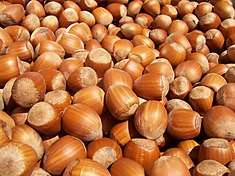
Fatsa is located on a strip of coastline between the Black Sea and the Janik Mountains (Turkish: Canik) and watered by the rivers of Elekçi, Bolaman, Yapraklı and Belice. The current population of the town is 74602.
Fatsa has a humid subtropical climate (Köppen: Cfa); hot and humid in summer, mild and damp in winter, with occasional - but heavy - snowfalls.
Economy
The local economy depends on agriculture and fishing. In the early 20th century, the town thrived as a port and trading post, as there was no coastal road to in the region. There are fishing fleets harboured at the port in Fatsa and in the small districts of Yalıköy and Bolaman (Polemonium) and in the hamlet of Belice, which forms a natural harbour. The Black Sea Coastal Highway runs through Fatsa bringing passing trade.
Before the 20th century, maize and rice were the main grains grown in the hinterland. From the 1920s onwards, the coastal swamps were dried up by irrigation works, rice growing ceased and the town grew. During this time, hazelnuts were introduced to the area. About 80% of arable land is planted with hazelnuts. The higher mountain areas of the district are covered in forest.
Places of interest

The countryside and coast of Fatsa are lush in spring and summer time. A number of places in and around the town attract visitors, including;
- The Belice rock on sea
- The ruins of the Pontic Greek Göreği Monastery, 5 km west of Fatsa
- Mount Çıngırt ancient rock tombs and vaults
- Lake Gaga - 10 km south-east of Fatsa
- The ruins of Bolaman Castle and the Haznedaroğlu mansion
- Town's promenade.
- The mineral water springs of Ilıca.
The annual Fatsa Çınar Festival was used to be held in July which included concerts, sports competitions, a beauty contest and various other activities. The last festival was held in 2008.
Notable natives
- Hekimoğlu İbrahim - Folk hero and outlaw who was involved in the skirmishes between the local Chveneburi (Muslim Georgian) and Turks in the early 20th century[31] (b. Fatsa ? - d. Fatsa 1918)
- Soytaroğlu İsmail - Folk hero and outlaw who was involved in the skirmishes between the local Chveneburi and Turks in the early 20th century (b. Vona ? - d. Ordu 1923)[32]
- Alexander Deligiannidis (Αλέξανδρος Δεληγιαννίδης) (b. Fatsa 1914 - Thessaloniki, Greece 1969) - Ethnic Pontic Greek from Fatsa. Served in the Greek Parliament as a member of the National Radical Union Party.
- Takis Terzopoulos (Τάκης Τερζόπουλος) (b. Fatsa 1920 - d. Katerini, Greece 1989) - Ethnic Pontic Greek from Fatsa. Served as a mayor of Katerini in Greece.
- Fikri Sönmez ("Fikri The Tailor") - Revolutionary, mayor of Fatsa. Ethnic Chveneburi (b. Fatsa 1938 - d. Amasya 1985)
- Ali Poyrazoğlu - Actor and director, who spent his childhood in Fatsa[33] (b. 1943, Istanbul - )
- Dursun Ali Akınet - Folk poet, ethnic Chveneburi[34] (b. Fatsa 1945 - )
- Kadir İnanır - Actor and director (b. Fatsa 1949 - )
- Erdoğan Arıca - Football player and coach (b. Fatsa 1954 - d. Istanbul 2012)
- Mehmet Gümüş - Singer[35] (b. Fatsa ? -)
- Eyüp Fatsa - Politician, member of the Turkish Parliament[36] (b. Fatsa 1961 - )
- Levent İnanır - Actor (b. Fatsa 1962 - )[37]
- İlhan Saygılı - Diplomat, served as the Consul General of Turkey in Frankfurt, Germany until 2011.[38] (b. Fatsa ? - )
- Soner Arıca - Model and singer (b. Fatsa 1966 - )
- Moody E. Prior - (1901-1996) - Ethnic Pontic Greek- Birth name Papadapolous- Northwestern University professor of the Humanities and English and an authority on Shakespeare - Dean of the Graduate School
References
- "Area of regions (including lakes), km²". Regional Statistics Database. Turkish Statistical Institute. 2002. Retrieved 2013-03-05.
- "Population of province/district centers and towns/villages by districts - 2012". Address Based Population Registration System (ABPRS) Database. Turkish Statistical Institute. Retrieved 2013-02-27.
-

- Friedrich Heinrich Theodor Bischoff, Vergleichendes Wörterbuch der alten, mittleren und neuen Geographie, 1829
- Richard J. A. Talbert, Barrington Atlas of the Greek and Roman World,
- Louis Vivien de Saint-Martin, Description historique et géographique de l'Asie Mineure, comprenant les temps anciens, le moyen age et les temps modernes, avec un précis détaillé des voyages qui ont été faits dans la péninsule, depuis l'époque des croisades jusqu'aux temps les plus récents; précédé d'un tableau de l'hstoire géographique de l'Asie, depuis les plus anciens temps jusqu'à nos jours.
- Anthony Bryer and David Winfield, The Byzantine Monuments and Topography of the Pontos (Dumbarton Oaks Research Library and Collection, 1985: ISBN 0-88402-122-X), p. 111.
- http://www.maproom.org/00/03/present.php?m=0049
- Putzgers, F.W., Historischer Schul-Atlas, Bielefeld, 1929
- DIMITRI KOROBEINIKOV (2003): Orthodox Communities in Eastern Anatolia in the Thirteenth and Fourteenth Centuries.1 Part 1: The Two Patriarchates: Constantinople and Antioch, Al-Masaq: Islam and the Medieval Mediterranean, 15:2, 197-214
- Rakova Snezhana, "Genoese in the Black Sea", Encyclopaedia of the Hellenic World, Black Sea
- BERAT YILDIZ, EMIGRATIONS FROM THE RUSSIAN EMPIRE TO THE OTTOMAN EMPIRE: AN ANALYSIS IN THE LIGHT OF THE NEW ARCHIVAL MATERIALS, BILKENT UNIVERSITY
- Αντώνης Κάλφας, Λογοτεχνικές εκδόσεις, μαρτυρίες και αφηγήσεις στην Πιερία (1918 - 2010), Πολιτιστικός Οργανισμός Δήμου Κατερίνης, 2011, ISBN 978-960-99702-0-4
- David Winfield et al., Some Byzantine Churches from the Pontus, Anatolian Studies, Vol. 12 (1962), pp. 131-161
- Morgül Kerem, A History of Social Struggles in Fatsa 1960-1980, Boğaziçi University, 2007.
- "Archived copy". Archived from the original on 2013-06-20. Retrieved 2013-06-18.CS1 maint: archived copy as title (link)
- Donald Presgrave Little et al., Islamic Studies Presented to Charles J. Adams, Brill Academic Pub; First Edition (April 1, 1991), ISBN 978-9004092211
- Léon Maccas, L’Hellenisme de L’Asie – Mineure, Paris, 1919, s: 83.
- Meir Zamir (1981): Population statistics of the Ottoman empire in 1914 and 1919, Middle Eastern Studies, 17:1, 85-106
- Tableaux indiquant le nombre des divers elements de la population dans l'Empire Ottoman au 1 Mars 1330 (14 Mars 1914), Constantinople
- Maccas, Léon, L'hellénisme de l'Asie-Mineure son histoire, sa puissance (1919)
- San Mateo Times /Thursday, March 30, 1972 /Page-1
- ENGİN BOZKURT, THE CRITICAL ANALYSIS OF ALTERNATIVE LOCAL GOVERNMENT EXPERIENCES IN TURKEY: THE CASE OF HOZAT MUNICIPALITY, MIDDLE EAST TECHNICAL UNIVERSITY, 2011
- TÜRKMEN, HADE, RADICALISATION OF POLITICS AT THE LOCAL LEVEL: THE CASE OF FATSA DURING THE LATE 1970s, MIDDLE EAST TECHNICAL UNIVERSITY, 2006
- SÜMERCAN BOZKURT, THE RESISTANCE COMMITTEES: DEVRIMCI YOL AND THE QUESTION OF REVOLUTIONARY ORGANIZATION IN TURKEY IN THE LATE 1970s, MIDDLE EAST TECHNICAL UNIVERSITY, 2008
- http://www.uludagsozluk.com/k/fatsa-nokta-operasyonu/
- "Milliyet - Ece Temelkuran - Teferruat!" (in Turkish). Retrieved 12 November 2008.
- "Bir Yerel Yönetim Deneyi" by Pertev Aksakal (Simge Yayınevi) 1989
- "Fatsalı'nın ikinci vatanı Japonya". Sabah (in Turkish). 2005-10-01. Retrieved 2009-02-24.
- "Archived copy". Archived from the original on 2012-12-05. Retrieved 2013-06-16.CS1 maint: archived copy as title (link)
- BOA DH. MTV 55/48.
- http://www.ordukentgazetesi.com/news_print.php?id=810
- "Archived copy". Archived from the original on 2013-06-26. Retrieved 2013-06-16.CS1 maint: archived copy as title (link)
- http://www.gdd.org.tr/koydetay.asp?id=282
- "Archived copy". Archived from the original on 2013-06-27. Retrieved 2013-06-16.CS1 maint: archived copy as title (link)
- http://www.tbmm.gov.tr/develop/owa/milletvekillerimiz_sd.bilgi?p_donem=23&p_sicil=5917
- http://www.biyografistan.com/2013/05/levent-inanir-kimdir-biyografisi.html
- http://euturkhaber.com/t-c-frankfurt-baskonsolosu-ilhan-saygilidan/
External links
- District governor's official website (in Turkish)
